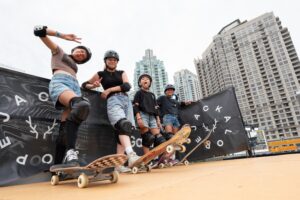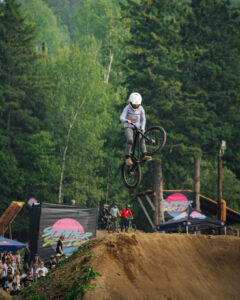Sports are a powerful means of empowerment, offering undeniable benefits for physical, mental, and social health. Yet, according to the Rally Report by Canadian Women & Sport, girls in Canada are dropping out of sports at alarming rates:
– Up to 62% of Canadian teenage girls do not participate in any sports.
– 1 in 3 girls who have played a sport quit by late adolescence—over three times the dropout rate of boys.
– Only 18% of women aged 16 to 63 remain engaged in sports.
Voir cette publication sur Instagram
And in action sports—such as skateboarding, snowboarding, mountain biking, and whitewater sports—women are still underrepresented and less likely to participate. In response, 100% women-only sports communities are emerging and experiencing massive success, with growing demand. After all, coordination and reflexes can be developed like any other skill!
Why are these women’s sports gatherings so essential? What barriers do they break down? How do they help women dare to try, progress, and thrive in these disciplines?
THE IMPORTANCE OF A SAFE AND SUPPORTIVE SPACE
43% of teenage girls reported that the quality of their sports experience was a barrier to participation.
1 in 5 girls aged 6 to 17 mentioned concerns about bullying and safety (violence/harassment) as a major reason for quitting sports.
In mixed-gender environments, some women may feel intimidated or pressured due to societal expectations and gender stereotypes. The emphasis on performance and competition in sports can also discourage some women. Women-only groups provide a more relaxed atmosphere where the focus is on enjoyment, mutual support, and personal progress—allowing each woman to learn freely without fear of judgment.

Additionally, seeing others succeed plays a key role in women’s motivation. When a woman sees someone like her succeeding, she thinks, “If she can do it, then so can I!” In contrast, mixed-gender settings where men often have a higher skill level can be discouraging (“He’s stronger than me, I’ll never get there”)—but in an all-female environment, it’s easier to envision success and dare to try. Practicing sports among women removes pressure, encourages pushing personal limits without fear, and fosters freedom to express oneself.
In these spaces, the goal isn’t to be the best—it’s to move at your own pace, learn while having fun, and share enriching moments that make sports a sustainable practice. As Annie Guglia says in the documentary Sportives sur l’Adrénaline during the Girls Sk8 Day:
“The important thing is to build a community. The girls in Akwesasne come here and meet others who skate too, and that gives them a shared experience. It helps them build bonds, and hopefully, they’ll keep skating together for a long time.”
Voir cette publication sur Instagram
BREAKING STEREOTYPE AND OVERCOMING IMPOSTOR SYNDROME
1 in 3 girls cites the following barriers to sports participation*:
Low self-confidence
Negative body image
Perceived lack of skill
Weak sense of belonging
Feeling unwelcome
(*Source)
Sports were designed by and for men. Stereotypes like “running like a girl” and the widespread belief that women are inherently less skilled than men reinforce a sense of illegitimacy in many women. This ingrained social conditioning affects how women perceive their own athletic abilities, creating mental blocks that need to be overcome. Women-only sports spaces help dismantle these biases and provide an environment where progress is encouraged without constant comparison to male performance.
Voir cette publication sur Instagram
In the Sportives sur l’Adrénaline web series, Samantha Secours shares her experience:“I’ve been told so many times, ‘You’ve got style—for a girl,’ or ‘You skate like a guy.’ Am I supposed to say thank you?! It’s rough to hear, and I hear it all the time.”
By coming together, women prove they belong in these so-called ‘masculine’ sports and actively challenge outdated perceptions. The more visible women become in action sports, the more young girls will have role models to look up to—opening the door to greater female representation and encouraging more women to join in.

Sports expert Guylaine Demers states in Sportives sur l’Adrénaline:“We need to break stereotypes about girls in sports. We can do whatever we want if we have the opportunity to develop our skills.”Annie Guglia adds:“There are little girls now who don’t even realize skateboarding used to be a ‘boys’ sport!’” For the next generation of girls who grow up seeing female athletes and training alongside them, sports won’t feel gendered—they’ll simply go for it without hesitation.
Voir cette publication sur Instagram
SHARING EXPERIENCES AND OVERCOMING COMMON CHALLENGES
Women face unique challenges in sports—whether related to physiology (menstrual cycles, pregnancy, postpartum, menopause) or social pressures (work-life balance, mental load, lack of female role models). In women-only communities, these realities are understood and addressed. They become normal topics of discussion, rather than barriers to sports participation.
Some elite teams even integrate these factors into their approach. For example, the U.S. Women’s National Soccer Team tracks their players’ menstrual cycles to tailor training programs, optimize performance, and reduce injury risk. This initiative demonstrates how meeting women’s specific needs can significantly enhance both well-being and performance in sports.
In the Sportives sur l’Adrénaline episode on freestyle skiing, Olivia Asselin, X Games gold medalist, states:”I think all of us girls would agree that having a female presence in the team would make us feel much more understood.”
Voir cette publication sur Instagram
The Keeping Girls in the Game study by the Women’s Sports Foundation also highlights that girls who appreciate their coach are more motivated to continue playing sports in the future. Building positive relationships between teammates and between athletes and coaches is essential. With male coaches, some women report feeling “mansplained” to. While the line is subtle, receiving guidance from a woman who fully understands their challenges can be more empowering. Female leadership in sports coaching will be the focus of our next article.
Women-only spaces allow women to take on active roles, learn without condescension, and recognize their own physical strength and independence.
5 WOMEN-LED SPORTS COMMUNITIES TO DISCOVER
Looking for a supportive group to start or progress in action sports? Here are some inspiring communities:
👉 Les Chèvres de Montagne – Canada’s leading outdoor women’s community, offering hiking, climbing, mountain biking, skiing, canoe camping, fishing, and even first aid training. Their mission: boost women’s confidence in the outdoors through training and progression events.
Voir cette publication sur Instagram
👉 Les Poules qui roulent – A community of passionate female mountain bikers dedicated to making the sport safe and fun for all. Plus, you can start your own local chapter if your region isn’t covered—go for it!
👉 Pink Water – A collective proving that whitewater sports are accessible to all. Women of all ages are encouraged to join, boosting self-confidence and personal growth.
Voir cette publication sur Instagram
👉 Canton Shred au Féminin (Estrie), Les Vagabonnes (Montreal), & Comelady (Quebec-wide) – Groups supporting women of all levels in skateboarding, helping them overcome intimidation in skateparks through community encouragement.
👉 Salty Souls – A surf community empowering women through sports, personal growth, and adventure. Their Salty Club helps women stay fit, mindful, and confident anywhere in the world, year-round.
Voir cette publication sur Instagram
TOWARD A MORE INCLUSIVE SPORTS CULTURE
Encouraging 100% women-only spaces isn’t about excluding men—it’s about creating environments where women can thrive, develop skills, and build confidence. These initiatives help correct access inequalities and transform sports culture in a lasting way.
The movement is growing—let’s support it and create more spaces where every woman can embrace sports without limits. 🚀💪